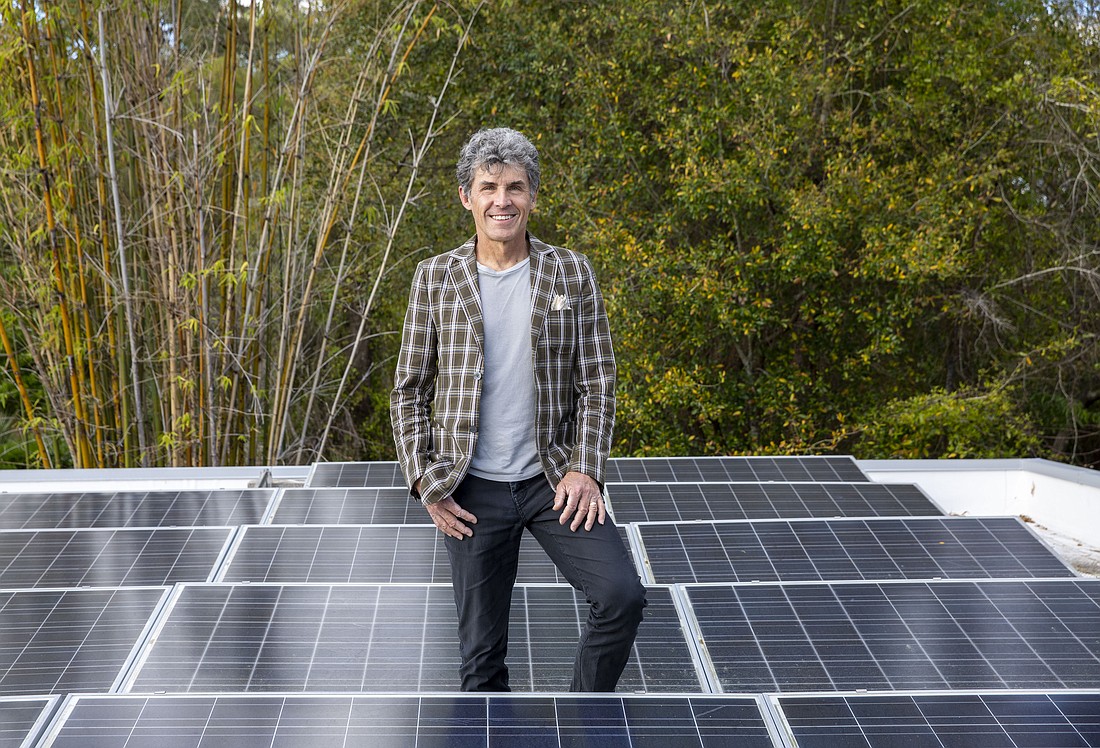Change — as in climate change — is at the core of Ken LaRoe’s latest banking venture.
Climate First Bank, the third community bank he’s founded, recently celebrated two years in business. Headquartered in St. Petersburg, it provides traditional banking services but its lending activity is heavily focused on financing solar-energy installations, electric vehicle charging stations and other green-based innovations.
The bank had $8.6 million in revenue in 2022, and through March 31 it had $332.79 million in assets, according to Federal Deposit Insurance Corp. data. “It’s just like everything converged, now is the time, and it’s all paying off,” LaRoe says.
LaRoe, however, is no cynical opportunist who merely talks the talk. Environmental sustainability and progressive values have long been part of his DNA as a businessman. For example, the bank he founded in 2009, Mount Dora-based First Green Bank, was the first bank in the eastern United States with an environmental and social responsibility mission statement. It backed up its words by providing low-interest commercial loans for solar energy projects and banking services to the medical marijuana industry.
Prior to its official opening in June 2021, Climate First Bank proved there was an appetite for its model, when it raised $44 million. Now entering the final year of its regulatory startup stage, LaRoe says the bank aspires to quickly expand its loan portfolio beyond Florida. “We’re encouraged not to lend outside of the state until we get out of de novo,” he says, “but if we’ve got a sponsor in Florida, we can do it.”
That provision has allowed Climate First Bank to finance projects generating large amounts of megawatts but also smaller ones that at first glance might not fit the bank’s mission statement. That’s what happened in the case of a gas station and convenience store loan that LaRoe didn’t think the bank would approve.
“It was quite fascinating,” he says. “That was our first loan that went to our directors’ committee, because it was over a certain amount. It was big, like $5 million for new construction of a giant convenience store, similar to a Wawa. One of my directors was really opposed to it. Our sustainability officer was really opposed to it, saying, ‘It’s the last mile of dirty energy. It’s a convenience store. There’s nothing in there that’s good for humans.’”
LaRoe, however, saw an opportunity. The bank got the developers to agree to cover the convenience store’s roof with solar panels and install electric vehicle charging stations.
“That’s a ‘just transition,’ in quotes,” he says. “You’ve probably heard that talked about. We have to have ‘just transitions.’” For example, “We can’t just leave everybody in Appalachia without jobs because there's no more coal.”
The loan won approval with just one director objecting, and the process makes it more likely similar future deals will be OK’d, because gas station developers and operators, LaRoe says, “know they’re not going to be pumping gas in 15 years.”
So far, LaRoe hasn’t noticed many banks in Florida following the lead of Climate First Bank, but on a national level, there’s been some traction. For example, Forbright Bank, a $6.4 billion Potomac, Maryland-based institution, is solely focused on reduction of greenhouse gas emissions. “They’re all over it,” LaRoe says. “There’s some cool stuff going on. It's just, unfortunately, not in Florida.”
Still, the bank’s impact hasn’t gone unnoticed. In April, for example, it added a prominent board member: Jarred Fayson, who played wide receiver for the Florida Gators during the 2006 national championship season and today is a Nature Conservancy board member in addition to serving as chairman of the Fisheries Council’s Florida chapter.
The bank has also been aggressive in the fintech space, acquiring Ecountabl, a startup that created a way to index environmental, social and governance performance for more than 10,000 companies, allowing customers to track how brands from which they buy align with their personal values. Climate First Bank already had a similar system in place called OneEthos — a wholly owned subsidiary the bank credits with helping it reach more than $200 million in assets and exceed $140 million in loans within its first 12 months in business — but jumped at the chance to merge it with an industry leader.
The combined OneEthos/Ecountabl platform hasn’t launched yet, but LaRoe anticipates it will resonate with a growing number of ethically minded consumers. (On the flip side, Gov. Ron DeSantis, Florida CFO Jimmy Patronis and the Florida legislature have recently enacted rules that would curb the influence of ESG policies, at least in official state business.)
By the end of the year or in the first quarter of 2024, Climate First Bank will have a more prominent location, as it’s currently building a new headquarters. It will be a certified LEED Platinum structure, at 182 37th Ave. N. in St. Pete, across from a Whole Foods grocery store also under construction. The existing building at that address has been completely gutted, LaRoe says, but the renovation work has been going “painfully slow.”
“It’s coming along,” LaRoe says. “It’s all approved and in construction, but this supply-chain thing, they say it’s over, but it’s not even remotely over.”






